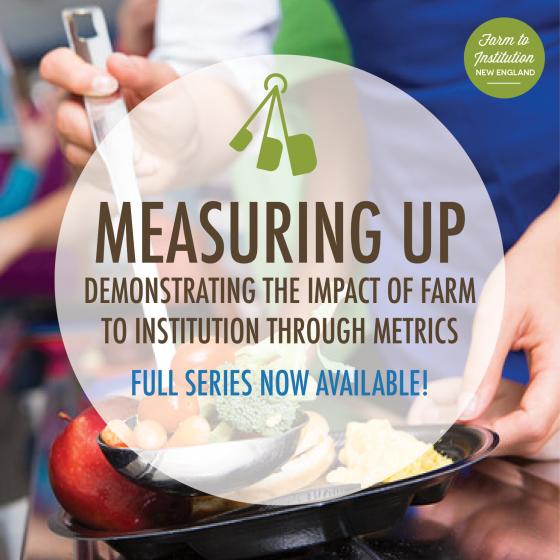Posted December 19, 2017 at 10:30am by Kaitlin Haskins
FINE Releases Six-Part Blog Series Demonstrating the Impact of Farm to Institution Through Metrics

Measuring Up, a six-part blog series by Farm to Institution New England (FINE) designed to provide an introduction to the importance of data in understanding the farm to institution landscape in New England, is now available in full on FINE's website. There are 4,628 K-12 schools, 210 colleges and universities, and 256 hospitals that provide dining services in New England. In total, they feed an estimated 3.8 million people per day [1].
This includes students, patients, visitors, faculty, and staff (institutions are among the largest employers in New England; according to each state's Department of Labor, all but one New England state – Connecticut – has an institution or institutional system as its largest employer [2]). Institutions have the opportunity and the power to significantly impact the food system by supporting local producers and feeding their constituents fresh, healthy foods.
Establishing a baseline for local food procurement from which progress can be measured is an essential step in mobilizing the power of institutions to transform the food system. Our metrics work helps us and our partners understand the system we are trying to change. This blog series provides an overview of the top findings from over two years of work dedicated to understanding that system and the key indicators for farm to institution success across the value chain.
Measuring Up consists of the following five installments:
-
An Introduction to the New England Farm to Institution Metrics Blog Series
-
Producer Perspectives: Who is providing institutional product?
-
Data-Driven Recommendations for Achieving Farm to Institution Success
The full series is available at dashboard.farmtoinstitution.org/measuring-up
Data used by the FINE metrics work team comes from several national sources like the USDA's Farm to School Census, Census of Agriculture, Local Food Marketing Practices Survey and Food Environment Atlas; Real Food Challenge; and research conducted by Health Care Without Harm and other core partners.
Where important gaps in the data were identified, original surveys were designed and implemented by the FINE metrics team. These have established primary data on New England distributors, colleges and universities, and producers as they each pertain to the farm to institution market.
Results of this work are also available through a series of reports, state profiles, and an interactive dashboard. If you have any questions or comments, contact Nessa Richman, FINE's research and evaluation director, at nessa@farmtoinst.org.
[1] K-12: U.S. Department of Education, National Center for Education Statistics, Common Core of Data (CCD) SY2012-2013 - nces.ed.gov/programs/digest/d14/tables/dt14_203.20.asp
Colleges: U.S. Department of Education, National Center for Education Statistics, Integrated Postsecondary Education Data System (IPEDS) - SY 2009-2010 via nces.ed.gov/programs/stateprofiles/index.asp
Hospitals: American Hospital Directory - "Numbers of staffed beds are taken from a hospital's most recent Medicare cost report (W/S S-3, Part I, col.1)." - www.ahd.com/state_statistics.html
Hospitals: Occupancy Rate - American Hospital Association Annual Survey of Hospitals. Hospital Statistics, 1976, 1981, 1991–2011 editions. Chicago, IL. (Copyright 1976, 1981, 1991–2011: Used with the permission of Health Forum LLC, an affiliate of the AHA.) See Appendix I, American Hospital Association (AHA) Annual Survey of Hospitals. www.cdc.gov/nchs/data/hus/2011/116.pdf
Hospitals: Health Care Employment - Bureau of Labor Statistics, State Occupational Employment Statistics Survey, May 2014 kff.org/other/state-indicator/total-health-care-employment/
[2] The Maine Department of Labor specifies that this list includes the top private employers in the state.
